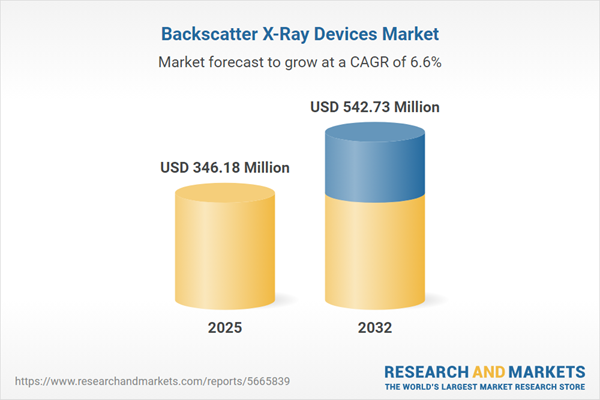Speak directly to the analyst to clarify any post sales queries you may have.
Backscatter X-ray devices are redefining inspection and security protocols across security, medical, and industrial sectors. With evolving regulatory frameworks and technological advancements, these systems are becoming essential for organizations requiring streamlined, reliable, and compliant non-invasive inspection solutions.
Market Snapshot: Backscatter X-Ray Devices Market Overview
The Backscatter X-Ray Devices Market grew from USD 325.45 million in 2024 to USD 346.18 million in 2025. It is expected to continue growing at a CAGR of 6.60%, reaching USD 542.73 million by 2032. This robust expansion is driven by heightened demand for rapid, accurate detection across airports, borders, manufacturing lines, and healthcare facilities. Organizations are pursuing systems that balance imaging clarity, user safety, and regulatory compliance while offering integration with digital platforms and analytics for operational intelligence.
Scope & Segmentation of the Backscatter X-Ray Devices Market
This market study provides a comprehensive analysis across critical segments, technology types, regional deployments, and major players:
- Type: Fixed Backscatter X-ray Scanners, Handheld Backscatter X-ray Scanners
- Technology: Dual-Energy Backscatter Systems, Multi-View Backscatter Systems, Single-Sided Backscatter Imaging
- Application: – Industrial Inspection: Non-destructive Testing (NDT), Pipeline & Structural Inspection, Product Quality Assurance – Medical Applications: Diagnostic Imaging, Radiation Therapy Support – Security & Screening: Airport Security, Border Security, Customs & Cargo Inspection, Public Event Screening
- End-User Industry: Commercial, Government, Healthcare, Industrial, Transportation
- Regional Coverage: – Americas: North America (United States, Canada, Mexico), Latin America (Brazil, Argentina, Chile, Colombia, Peru) – Europe, Middle East & Africa: Europe (United Kingdom, Germany, France, Russia, Italy, Spain, Netherlands, Sweden, Poland, Switzerland), Middle East (United Arab Emirates, Saudi Arabia, Qatar, Turkey, Israel), Africa (South Africa, Nigeria, Egypt, Kenya) – Asia-Pacific: China, India, Japan, Australia, South Korea, Indonesia, Thailand, Malaysia, Singapore, Taiwan
- Key Companies: Amptek Inc., analyticon instruments gmbh, Astrophysics Inc., Autoclear LLC, Gilardoni S.p.A, Lancs Industries, LAURUS Systems, Inc., Lomini Ltd., Micro-X Limited, MinXray, Inc., Nuctech Company Limited by Tsinghua Tongfang Co., Ltd., Rapiscan Systems Inc. by OSI Systems, Inc., Scan-X Security Ltd., Scanna MSC Ltd., Shanghai Eastimage Equipment Co., Ltd., Shenzhen Uni X-ray Technology Limited, Smiths Detection Group Limited, Videray Technologies, Inc., Viken Detection, Westminster Group Plc
Key Takeaways for Senior Decision-Makers
- Integrated security ecosystems now require backscatter X-ray devices to seamlessly interface with artificial intelligence (AI), cloud data systems, and sensor networks, significantly boosting operational value and responsiveness.
- Regulatory demands concerning radiation safety and data privacy are intensifying, encouraging innovation in modular architectures and adaptive threat detection to support ongoing compliance and simplify future upgrades.
- Portability and flexibility are driving adoption, with a marked increase in demand for handheld and decentralized screening devices that do not compromise imaging accuracy or safety.
- Vendor competition is shifting towards investment in local service capabilities, outcome-based service models, and partnerships for technology validation, giving end users expanded support options and streamlined device lifecycle management.
- Advanced machine learning in imaging workflows is reducing manual review requirements, improving anomaly detection accuracy, and allowing security and inspection teams to focus resources on high-value investigations.
Tariff Impact Analysis
Recent United States tariffs on imported imaging components have increased manufacturing costs and prompted vendors to diversify supply chains, prioritize domestic sourcing, and accelerate qualification of alternative suppliers. These shifts have introduced new lead time and cost variables for buyers, leading some organizations to adjust procurement strategies or renegotiate service agreements in key sectors such as border security and aerospace.
Methodology & Data Sources
This research incorporates primary interviews with manufacturers, procurement leaders, and regulatory experts, complemented by secondary analysis of technical literature, government publications, and industry databases. Quantitative insights are cross-verified through data triangulation and validated with expert panels, ensuring reliable and actionable market intelligence.
Why This Report Matters for Senior Leadership
- Offers transparent, reliable segmentation and technology insights to support investment prioritization and procurement decisions.
- Delivers a strategic lens on regulatory, supply chain, and innovation trends shaping long-term adoption and competitive advantage.
- Serves as a comprehensive reference to shape R&D, partnership, and go-to-market strategies in response to evolving market and policy dynamics.
Conclusion
The backscatter X-ray devices market is evolving through regulatory, technological, and supply chain transformation. Informed leadership and agile strategies will define which organizations capture future opportunities, strengthen security postures, and deliver operational excellence in a dynamic landscape.
Additional Product Information:
- Purchase of this report includes 1 year online access with quarterly updates.
- This report can be updated on request. Please contact our Customer Experience team using the Ask a Question widget on our website.
Table of Contents
3. Executive Summary
4. Market Overview
7. Cumulative Impact of Artificial Intelligence 2025
Companies Mentioned
The companies profiled in this Backscatter X-Ray Devices market report include:- Amptek Inc.
- analyticon instruments gmbh
- Astrophysics Inc.
- Autoclear LLC
- Gilardoni S.p.A
- Lancs Industries
- LAURUS Systems, Inc.
- Lomini Ltd.
- Micro-X Limited
- MinXray, Inc.
- Nuctech Company Limited by Tsinghua Tongfang Co., Ltd.
- Rapiscan Systems Inc. by OSI Systems, Inc.
- Scan-X Security Ltd.
- Scanna MSC Ltd.
- Shanghai Eastimage Equipment Co., Ltd.
- Shenzhen Uni X-ray Technology Limited
- Smiths Detection Group Limited
- Videray Technologies, Inc.
- Viken Detection
- Westminster Group Plc
Table Information
| Report Attribute | Details |
|---|---|
| No. of Pages | 193 |
| Published | November 2025 |
| Forecast Period | 2025 - 2032 |
| Estimated Market Value ( USD | $ 346.18 Million |
| Forecasted Market Value ( USD | $ 542.73 Million |
| Compound Annual Growth Rate | 6.6% |
| Regions Covered | Global |
| No. of Companies Mentioned | 21 |









